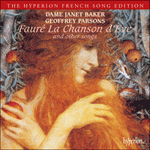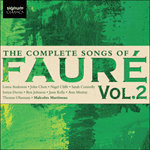Some twenty years before his life-changing visit to Venice with Winnaretta Singer (later the Princesse de Polignac) Fauré evokes the haunting bitter-sweet mood of ‘Serenissima’, with its gondolier calls resounding across the lagoons. The vocal bel canto, inspired by Chopin’s great
Barcarolle, Op 60, and ornamented with Italianate acciaccature, is launched high in the stave and topples down in conjunct harmonic steps, a procedure which is a distinguishing feature in Fauré’s songs of the early period. The accompaniment is merely an echo of this quasi-improvised vocal flowering; the piano here temporarily withdraws as the driving force behind the composer’s ideas,
reculer pour mieux sauter. Once again this song is dedicated to Madame Viardot. Its inclusion in the Second Collection of songs, rather than the first where it truly belongs, results from a complicated piece of publishing history concerning Hamelle’s desire to equalize the number of songs in each of the collections to a round figure of twenty. The heading of the lyric in the 1872 edition of poems by Marc-Monnier (whose name is thus hyphenated by the publisher Lemerre) contains the words ‘Musique de F Gratz’ (Franz Gratz, 1803–1874, a Swiss composer resident in Paris, once well known).
from notes by Graham Johnson © 2005
Quelque vingt ans avant le séjour passé à Venise en compagnie de Winnaretta Singer (future princesse de Polignac)—un séjour qui allait changer sa vie—, Fauré évoque la lancinante atmosphère douce-amère de la «Sérénissime», avec les appels des gondoliers résonnant à travers ses lagunes. Le bel canto vocal, inspiré par la grande
Barcarolle, op.60 de Chopin et orné d’
acciaccature italianisantes, est déclenché haut dans la portée et bascule en degrés harmoniques conjoints—un procédé qui est l’une des marques distinctives des mélodies du Fauré première manière. L’accompagnement est un simple écho de ce flux vocal quasi improvisé: le piano se retire ici momentanément, comme la force agissante des idées du compositeur—reculer pour mieux sauter. Cette mélodie est, comme la précédente, dédiée à Madame Viardot. Son insertion dans le deuxième Recueil, plutôt que dans le premier auquel elle appartient réellement, résulte d’une complexe histoire d’éditeur, Hamelle souhaitant que chaque recueil totalise le chiffre rond de vingt mélodies. L’en-tête du poème lyrique, paru dans l’édition de 1872 des poèmes de Marc-Monnier (dont le nom est écrit ainsi, avec un trait d’union, par l’éditeur Lemerre), comporte les mots «Musique de F. Gratz» (Franz Gratz, 1803–1874, un compositeur suisse, autrefois célèbre, installé à Paris).
extrait des notes rédigées par Graham Johnson © 2005
Français: Hypérion


 Fauré: La chanson d'Ève & other songs
Fauré: La chanson d'Ève & other songs Fauré: The Complete Songs, Vol. 2
Fauré: The Complete Songs, Vol. 2 Souvenirs de Venise
Souvenirs de Venise
